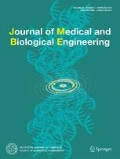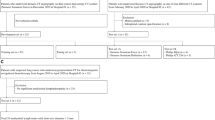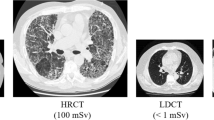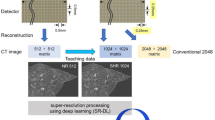Abstract
Purpose
To evaluate the usefulness of applying computed tomography (CT) images reconstructed by a deep learning super-resolution method to the clinical scenario of planning a real bronchoscopy procedure.
Methods
We trained a super-resolution generative adversarial network (SRGAN) to reconstruct CT images to high-resolution (SRGANrc). We tasked three pulmonologists with evaluating the quality of the CT images and the derived virtual bronchoscopies. We also compared the number of bronchi that were segmented by an automatic commercial program with the number of bronchi segmented in different processed thin-sectioned CT images.
Results
Regarding the human visual score, the original thin-sectioned CT images received more votes than the reconstructed CT images (SRGANrc) (29 votes versus eight votes). As for the human classification of four high-resolution CT images, the majority of images (83.7%) were classified correctly. Four out of 23 virtual bronchoscopies derived from super-resolution CT images were considered superior. The number of automatically segmented bronchi in super-resolution CT images was on average 1.5 less than that in the original thin-sliced CT images (mean bronchi: 15.1 vs. 16.6).
Conclusion
The reconstruction of super-resolution CT images through the SRGAN may have limited applications in the clinical scenarios of our study. In addition to improving the deep-learning algorithm, we need more clinical implementation tests to discover its value.


Similar content being viewed by others
References
Matsumoto, Y., Izumo, T., Sasada, S., Tsuchida, T., & Ohe, Y. (2015). Diagnostic utility of endobronchial ultrasound with a guide sheath under the computed tomography workstation (ziostation) for small peripheral pulmonary lesions. The Clinical Respiratory Journal. https://doi.org/10.1111/crj.12321
Minezawa, T., Okamura, T., Yatsuya, H., Yamamoto, N., Morikawa, S., Yamaguchi, T., Morishita, M., Niwa, Y., Takeyama, T., Mieno, Y., & Hoshino, T. (2015). Bronchus sign on thin-section computed tomography is a powerful predictive factor for successful transbronchial biopsy using endobronchial ultrasound with a guide sheath for small peripheral lung lesions: A retrospective observational study. BMC Medical Imaging. https://doi.org/10.1186/s12880-015-0060-5
Isaac, J. S., & Kulkarni, R. (2015). Super resolution techniques for medical image processing. https://doi.org/10.1109/ICTSD.2015.7095900
Bing, X., Zhang, W., Zheng, L., & Zhang, Y. (2019). Medical image super resolution using improved generative adversarial networks. IEEE Access. https://doi.org/10.1109/ACCESS.2019.2944862
Ledig, C., Theis, L., Huszar, F., Caballero, J., Cunningham, A., & Acosta, A. (2017). Photo-realistic single image super-resolution using a generative adversarial network. arXiv:1609.04802
Zhu, J., Yang, G., & Lio, P. (2019). How can we make Gan perform better in single medical image super-resolution? A lesion focused multi-scale approach. https://doi.org/10.1109/ISBI.2019.8759517
Mahapatra, D., Bozorgtabar, B., & Garnavi, R. (2019). Image super-resolution using progressive generative adversarial networks for medical image analysis. Computerized Medical Imaging and Graphics. https://doi.org/10.1016/j.compmedimag.2018.10.005
European Society of Radiology. (2011). Usability of irreversible image compression in radiological imaging. A position paper by the European Society of Radiology (ESR). https://doi.org/10.1007/s13244-011-0071-x
Yushkevich, P. A., Piven, J., Hazlett, H. C., Smith, R. G., Ho, S., Gee, J. C., & Gerig, G. (2006). User-guided 3D active contour segmentation of anatomical structures: Significantly improved efficiency and reliability. NeuroImage. https://doi.org/10.1016/j.neuroimage.2006.01.015
Jenkinson, M., & Smith, S. M. (2001). A global optimisation method for robust affine registration of brain images. Medical Image Analysis. https://doi.org/10.1016/s1361-8415(01)00036-6
Westphalen, A. C., Noworolski, S. M., Harisinghani, M., Jhaveri, K. S., Raman, S. S., Rosenkrantz, A. B., Wang, Z. J., Zagoria, R. J., & Kurhanewicz, J. (2016). High-resolution 3-T endorectal prostate MRI: A multireader study of radiologist preference and perceived interpretive quality of 2D and 3D T2-weighted fast spin-echo MR images. https://www.ajronline.org/. https://doi.org/10.2214/AJR.14.14065
Acknowledgements
The authors gratefully acknowledge partial financial support by the Veteran General Hospitals University System of Taiwan under Grant No. VGHUST110-G7-2-1.
Author information
Authors and Affiliations
Corresponding author
Rights and permissions
About this article
Cite this article
Chao, Hs., Shiao, TH., Chou, CW. et al. Computed Tomography Super-Resolution Using a Generative Adversarial Network in Bronchoscopy: A Clinical Feasibility Study. J. Med. Biol. Eng. 41, 592–598 (2021). https://doi.org/10.1007/s40846-021-00614-2
Received:
Accepted:
Published:
Issue Date:
DOI: https://doi.org/10.1007/s40846-021-00614-2




